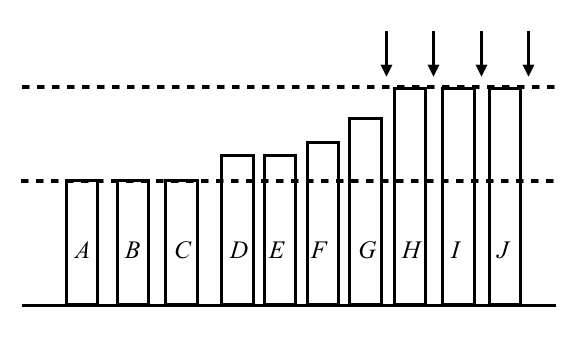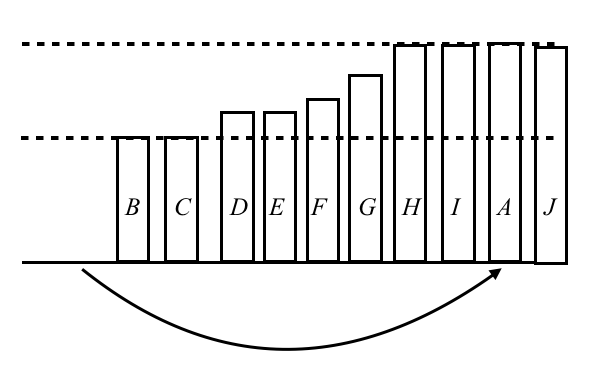diverta 2019 Programming Contest. E - Balanced Piles
https://atcoder.jp/contests/diverta2019-2/tasks/diverta2019_2_e
We shall explain O(NH) solution by dynamic programming. Suppose that the elements are lined up in ascending order. Consider this operation: choose the leftmost element, and increase it to the old maximum or larger. We repeat this operation until all elements become H.
In the following figure, we chose A and inserted A between I and J. As depicted in this figure, between G and H, between H and I, and after J are also possible. Generally, If there are j maximum elements, there are j+1 places we can insert into. After inserting A, we next insert B into somewhere, and then C, D, E, F ... are followed.


Let dp[i][j] be the number of ways such that the maximum is equal to i and the number of maximum elements is equal to j. Initially,
\[ dp[0][N]=1. \]
As stated above,
\[ \mathrel{\mathbf{if}} j \ne N \mathrel{\mathbf{then}} dp[i][j+1] \mathrel{{+}{=}} dp[i][j]*(j+1). \]
Moreover, we may increase the leftmost element to the strictly larger than i. Thus,
\[ \mathrel{\mathbf{for}} k=1 \mathrel{\mathbf{to}} D \mathrel{\mathbf{do}} dp[i+k][1] \mathrel{{+}{=}} dp[i][j].\]
Finally, the answer is
\[ dp[H][N]. \]
Let us speed up this dp. Carefully viewing the releation, we can notice that
\[ \mathrel{\mathbf{for}} k=1 \mathrel{\mathbf{to}} D \mathrel{\mathbf{do}} dp[i+k][1] \mathrel{{+}{=}} dp[i][1] + dp[i][2] + \cdots + dp[i][N]. \]
Since \( dp[i][j] = j! * dp[i][1] \), we can restate it as follows.
\[ \mathrel{\mathbf{for}} k=1 \mathrel{\mathbf{to}} D \mathrel{\mathbf{do}} dp[i+k][1] \mathrel{{+}{=}} (1! + 2! + \cdots + N!)*dp[i][1]. \]
Thus, we can solve this problem in O(N+H) time.
https://atcoder.jp/contests/diverta2019-2/submissions/5931171
#include <bits/stdc++.h> #define rep(i, n) for (int i = 0; i < (n); i++) #define repr(i, n) for (int i = (int)(n) - 1; i >= 0; i--) #define range(a) a.begin(), a.end() using namespace std; using ll = long long; const int MOD = 1000000007; struct mint { int n; mint(int n_ = 0) : n(n_) {} }; mint operator-(mint a) { return -a.n + MOD * (a.n != 0); } mint operator+(mint a, mint b) { int x = a.n + b.n; return x - (x >= MOD) * MOD; } mint operator-(mint a, mint b) { int x = a.n - b.n; return x + (x < 0) * MOD; } mint operator*(mint a, mint b) { return (long long)a.n * b.n % MOD; } mint &operator+=(mint &a, mint b) { return a = a + b; } mint &operator-=(mint &a, mint b) { return a = a - b; } mint &operator*=(mint &a, mint b) { return a = a * b; } istream &operator>>(istream &i, mint &a) { return i >> a.n; } ostream &operator<<(ostream &o, mint a) { return o << a.n; } void naive() { static mint dp[50][50]; int N, H, D; cin >> N >> H >> D; dp[0][N] = 1; for (int i = 0; i <= H; i++) { for (int j = 0; j <= N; j++) { for (int k = i + 1; k <= min(H, i + D); k++) { dp[k][1] += dp[i][j]; } if (j < N) { dp[i][j + 1] += dp[i][j] * (j + 1); } } } cout << dp[H][N] << endl; } int main() { int N, H, D; cin >> N >> H >> D; mint f = 1; mint s = 0; for (int i = 1; i <= N; i++) { f *= i; s += f; } vector<mint> dp(H + 2); // dp[i][1] dp[1] += 1; dp[D + 1] -= 1; for (int i = 1; i < H; i++) { dp[i + 1] += dp[i]; int l = i + 1; int r = min(H + 1, i + D + 1); dp[l] += dp[i] * s; dp[r] -= dp[i] * s; } mint ans = dp[H] * f; cout << ans << '\n'; }